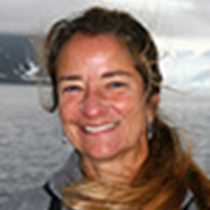Port Houghton and Stephens Passage
This morning under drizzly, low clouds we explored the bay named Port Houghton by foot and kayak. Tree branches were padded in the green, lush growth of mosses. Ferns grew on the mosses high in the trees. The ground, too, was covered by a thick cushion of soft mosses and dozens of other small plants. The forest was so very green, and so soft! It already was inhabited; moose droppings were plentiful, bears had dug up skunk cabbage tubers, there were red squirrel middens, and mouse holes in the ground.
Kayakers paddled up a marsh creek, and saw pink and dog salmon in the water below. A kingfisher flew past and chattered above.
Soon after leaving the bay, we saw humpback whales. We suspected feeding activity, so the hydrophone was lowered. Yes! We heard some vocalizations from the whales! In this region of Southeast Alaska, humpback whales are often feeding on krill. There were many other whales off in the distance, and in all directions around Sea Bird. Some were diving in pairs, others were solitary. Some young whales nearby breached. Could these be calves simply playing as their mothers fed? Or, were these calves "acting out" because mother was no longer feeding them? We watched dozens and dozens of breaches. It was extraordinary! Another whale lay on its back, slapping its enormous pectoral flippers down on the surface. No matter which direction one looked, there were whale blows, flukes and large white splashes.
In an attempt to estimate their numbers, I counted the whales and blows visible as I scanned the horizon with binoculars: 48, then 58, and 60. Assuming that many of the animals were underwater during the counts, there may have been close to 150 humpback whales in the area! Incredible! We spent more than three hours among the whales, and as we were departing we paused again to watch a group of lunge feeding humpbacks. It was a truly extraordinary afternoon and an unprecedented experience for all aboard, including crew and naturalists.
This morning under drizzly, low clouds we explored the bay named Port Houghton by foot and kayak. Tree branches were padded in the green, lush growth of mosses. Ferns grew on the mosses high in the trees. The ground, too, was covered by a thick cushion of soft mosses and dozens of other small plants. The forest was so very green, and so soft! It already was inhabited; moose droppings were plentiful, bears had dug up skunk cabbage tubers, there were red squirrel middens, and mouse holes in the ground.
Kayakers paddled up a marsh creek, and saw pink and dog salmon in the water below. A kingfisher flew past and chattered above.
Soon after leaving the bay, we saw humpback whales. We suspected feeding activity, so the hydrophone was lowered. Yes! We heard some vocalizations from the whales! In this region of Southeast Alaska, humpback whales are often feeding on krill. There were many other whales off in the distance, and in all directions around Sea Bird. Some were diving in pairs, others were solitary. Some young whales nearby breached. Could these be calves simply playing as their mothers fed? Or, were these calves "acting out" because mother was no longer feeding them? We watched dozens and dozens of breaches. It was extraordinary! Another whale lay on its back, slapping its enormous pectoral flippers down on the surface. No matter which direction one looked, there were whale blows, flukes and large white splashes.
In an attempt to estimate their numbers, I counted the whales and blows visible as I scanned the horizon with binoculars: 48, then 58, and 60. Assuming that many of the animals were underwater during the counts, there may have been close to 150 humpback whales in the area! Incredible! We spent more than three hours among the whales, and as we were departing we paused again to watch a group of lunge feeding humpbacks. It was a truly extraordinary afternoon and an unprecedented experience for all aboard, including crew and naturalists.




